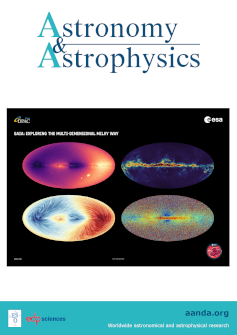TGO/CaSSIS观测的火卫一和火卫二的相位变红
IF 5.8
2区 物理与天体物理
Q1 ASTRONOMY & ASTROPHYSICS
引用次数: 0
摘要
目标。我们研究火卫一和火卫二的相位变红效应(即光谱斜率随相位角的增加),目的是表征两个火星卫星表面和光谱单元的起源和物理性质。我们分析了火卫一和火卫二在可见光到近红外波段的四滤光片观测结果,这些观测结果是由ESA的ExoMars痕量气体轨道器(TGO)上的彩色和表面立体成像系统(CaSSIS)在宽相位角范围内获得的。从这些观测结果中,我们推导出火卫一和火卫二亚火星半球的相位变红和光谱斜率的空间分布。我们提出了火卫一相位变红的第一个空间分辨图,以及火卫二在可见光到近红外波段的第一个全球相位变红的估计。我们的研究结果表明,(i)火卫一表面的特点是变量阶段变红,(ii)火卫二相似的阶段红红单位在火卫一,(3)成熟阶段红与风化层的数量,可以解释为空间气象,(iv)火卫一蓝色单元推迟Stickney影响和可能有外生起源、和(v)的风化层的物理性质火卫一和火卫二不同于火星地表。本文章由计算机程序翻译,如有差异,请以英文原文为准。
Phase reddening of Phobos and Deimos from TGO/CaSSIS observations
Aims. We study the phase-reddening effect (i.e. the increase in spectral slope with phase angle) of Phobos and Deimos, with the aim of characterising the origin and physical properties of the two Martian moon surfaces and spectral units.Methods. We analysed Phobos and Deimos four-filter observations at visible to near-infrared wavelengths acquired by the Colour and Surface Stereo Imaging System (CaSSIS) on board ESA’s ExoMars Trace Gas Orbiter (TGO) over a wide range of phase angles. From these observations, we derived the spatial distribution of the phase reddening and spectral slope over the sub-Mars hemispheres of Phobos and Deimos.Results. We present the first spatially resolved map of the Phobos phase reddening and the first estimate of the Deimos global phase reddening in the visible to near-infrared wavelengths.Conclusions. Our results suggest that (i) the surface of Phobos is characterised by variable phase reddening, (ii) the phase reddening of Deimos is similar to that of the redder units on Phobos, (iii) the amount of phase reddening is linked to regolith maturity and can be explained by space-weathering, (iv) the Phobos Blue unit post-dates the Stickney impact and may have an exogenous origin, and (v) the physical properties of the regolith on Phobos and Deimos are different from those of Martian regolith.
求助全文
通过发布文献求助,成功后即可免费获取论文全文。
去求助
来源期刊

Astronomy & Astrophysics
地学天文-天文与天体物理
CiteScore
10.20
自引率
27.70%
发文量
2105
审稿时长
1-2 weeks
期刊介绍:
Astronomy & Astrophysics is an international Journal that publishes papers on all aspects of astronomy and astrophysics (theoretical, observational, and instrumental) independently of the techniques used to obtain the results.
 求助内容:
求助内容: 应助结果提醒方式:
应助结果提醒方式:


